Hyundai Accent 2006 Workshop Manual
Manufacturer: HYUNDAI, Model Year: 2006, Model line: Accent, Model: Hyundai Accent 2006Pages: 599, PDF Size: 17.59 MB
Page 51 of 599

1
FEATURES OF YOUR HYUNDAI
37
WARNING:
o Do not install a child restraint seat at the center of the rear seat using the vehicle's ISOFIX anchors. The ISOFIX anchors are only providedfor the left and right outboard rear seating positions. Do not misuse the ISOFIX anchors by attemptingto attach a child restraint seat in the middle of the rear seat to the ISOFIX anchors. In a crash, thechild restraint seat ISOFIX attach- ments may not be strong enough to secure the child restraint seatproperly in the center of the rear seat and may break, causing seri- ous injury or death.
o When using the vehicle’s "ISOFIX" system to install a child restraintsystem in the rear seat, all unusedvehicle rear seat belt metal latch plates or tabs must be latched securely in their seat belt bucklesand the seat belt webbing must be retracted behind the child restraint to prevent the child from reachingand taking hold of unretracted seat
belts. Unlatched metal latch plates
B230D03MC
1. To engage the child restraint seat to the ISOFIX anchor, insert the child restraint seat latch into the ISOFIX anchor. Listen for the audible "click" sound.
2. Connect the tether strap hook to the child restraint hook holder and tightento secure the seat. Refer to "Secur-ing a Child Restraint System with the Tether Anchorage System" on page 1-34.
To secure the child restraint seat!or tabs may allow the child to reach the unretracted seat belts which may result in strangulationand a serious injury or death to the child in the child restraint.
o Do not mount more than one child
restraint to a child restraint loweranchorage point. The improper increased load may cause the an-chorage points or tether anchor to break, causing serious injury or death.
o Attach the ISOFIX or ISOFIX-com- patible child restraint seat only tothe appropriate locations shownin the illustration.
o Always follow the installation and
use instructions provided by themanufacturer of the child restraint.
Page 52 of 599
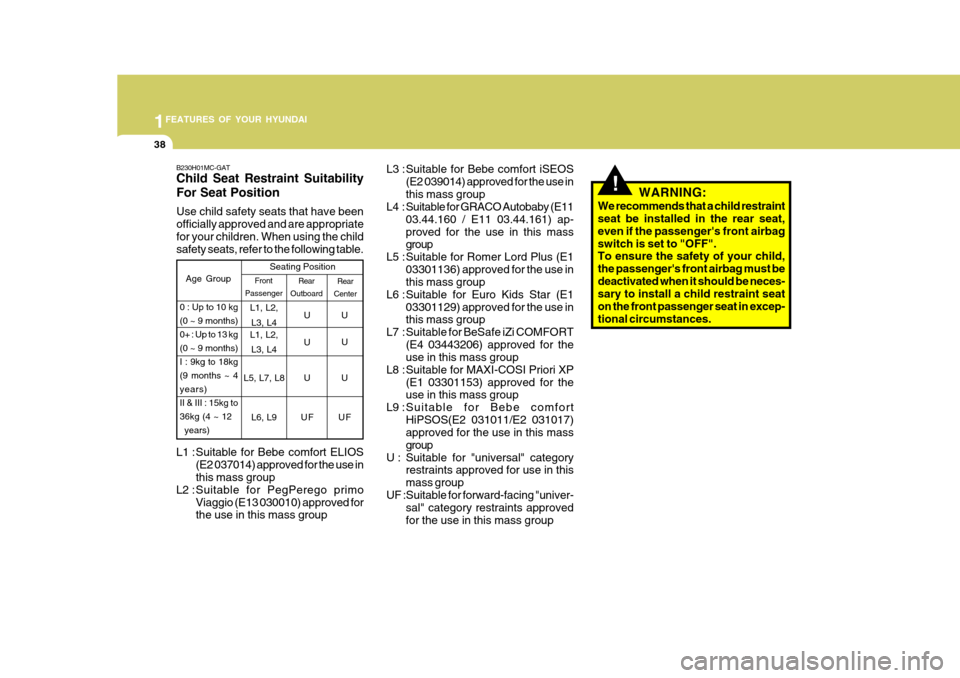
1FEATURES OF YOUR HYUNDAI
38
L1 : Suitable for Bebe comfort ELIOS(E2 037014) approved for the use in this mass group
L2 :Suitable for PegPerego primo Viaggio (E13 030010) approved forthe use in this mass group
B230H01MC-GAT Child Seat Restraint Suitability For Seat Position Use child safety seats that have been officially approved and are appropriatefor your children. When using the child safety seats, refer to the following table.
Rear
Center
Age Group Seating Position
UU
L1, L2, L3, L4 U
U
Rear
Outboard
Front
Passenger
0 : Up to 10 kg (0 ~ 9 months)0+ : Up to 13 kg(0 ~ 9 months)I : 9kg to 18kg(9 months ~ 4years)II & III : 15kg to36kg (4 ~ 12 years) L1, L2,
L3, L4
L5, L7, L8 UU
L6, L9 U F U F
L3 : Suitable for Bebe comfort iSEOS (E2 039014) approved for the use in this mass group
L4 : Suitable for GRACO Autobaby (E11
03.44.160 / E11 03.44.161) ap-proved for the use in this mass group
L5 : Suitable for Romer Lord Plus (E1 03301136) approved for the use inthis mass group
L6 : Suitable for Euro Kids Star (E1 03301129) approved for the use inthis mass group
L7 : Suitable for BeSafe iZi COMFORT (E4 03443206) approved for theuse in this mass group
L8 : Suitable for MAXI-COSI Priori XP (E1 03301153) approved for theuse in this mass group
L9 :Suitable for Bebe comfort HiPSOS(E2 031011/E2 031017)approved for the use in this mass group
U : Suitable for "universal" category restraints approved for use in thismass group
UF :Suitable for forward-facing "univer- sal" category restraints approvedfor the use in this mass group
!WARNING:
We recommends that a child restraint seat be installed in the rear seat, even if the passenger's front airbagswitch is set to "OFF". To ensure the safety of your child, the passenger's front airbag must bedeactivated when it should be neces- sary to install a child restraint seat on the front passenger seat in excep-tional circumstances.
Page 53 of 599
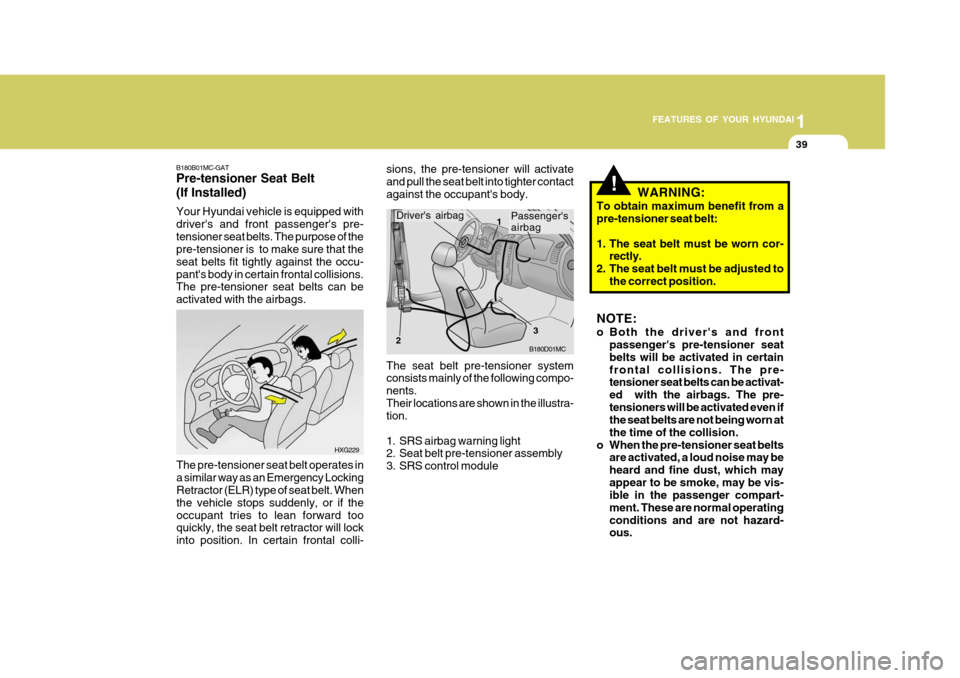
1
FEATURES OF YOUR HYUNDAI
39
!WARNING:
To obtain maximum benefit from a pre-tensioner seat belt:
1. The seat belt must be worn cor- rectly.
2. The seat belt must be adjusted to the correct position.
NOTE:
o Both the driver's and front passenger's pre-tensioner seat belts will be activated in certainfrontal collisions. The pre- tensioner seat belts can be activat- ed with the airbags. The pre-tensioners will be activated even if the seat belts are not being worn at the time of the collision.
o When the pre-tensioner seat belts are activated, a loud noise may beheard and fine dust, which mayappear to be smoke, may be vis- ible in the passenger compart- ment. These are normal operatingconditions and are not hazard- ous.
The seat belt pre-tensioner systemconsists mainly of the following compo- nents.Their locations are shown in the illustra- tion.
1. SRS airbag warning light
2. Seat belt pre-tensioner assembly
3. SRS control module
Passenger's airbag
B180D01MC
Driver's airbag1
2 3
sions, the pre-tensioner will activate and pull the seat belt into tighter contactagainst the occupant's body.
HXG229
B180B01MC-GAT Pre-tensioner Seat Belt (If Installed) Your Hyundai vehicle is equipped with driver's and front passenger's pre-tensioner seat belts. The purpose of the pre-tensioner is to make sure that the seat belts fit tightly against the occu-pant's body in certain frontal collisions. The pre-tensioner seat belts can be activated with the airbags.
The pre-tensioner seat belt operates ina similar way as an Emergency Locking Retractor (ELR) type of seat belt. When the vehicle stops suddenly, or if theoccupant tries to lean forward too quickly, the seat belt retractor will lock into position. In certain frontal colli-
Page 54 of 599
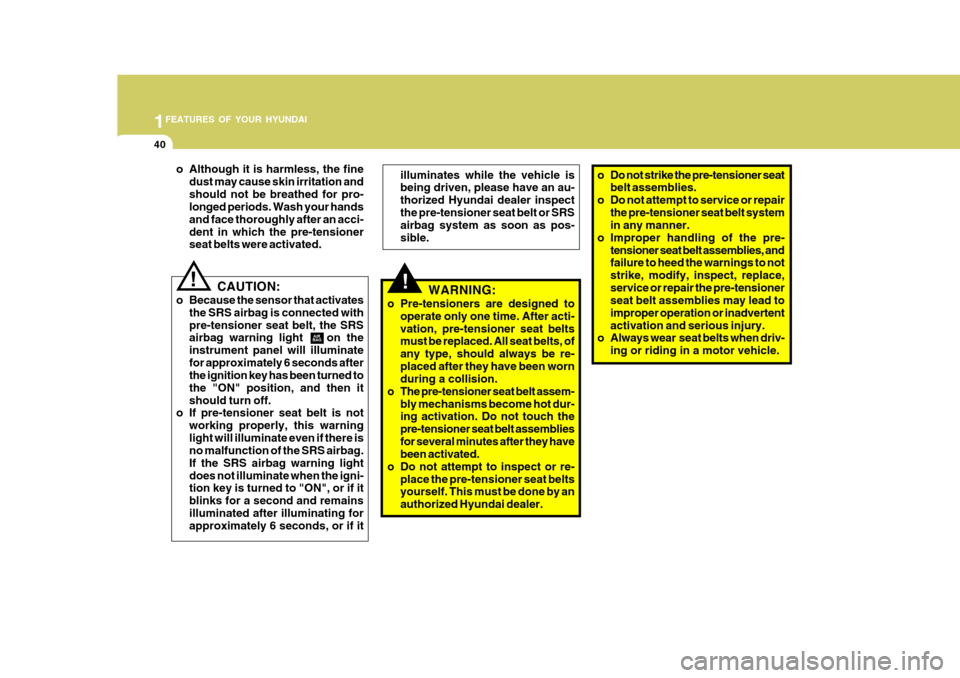
1FEATURES OF YOUR HYUNDAI
40
!
illuminates while the vehicle is being driven, please have an au- thorized Hyundai dealer inspectthe pre-tensioner seat belt or SRS airbag system as soon as pos- sible.
WARNING:
o Pre-tensioners are designed to operate only one time. After acti- vation, pre-tensioner seat belts must be replaced. All seat belts, of any type, should always be re-placed after they have been worn during a collision.
o The pre-tensioner seat belt assem- bly mechanisms become hot dur-ing activation. Do not touch the pre-tensioner seat belt assembliesfor several minutes after they have been activated.
o Do not attempt to inspect or re- place the pre-tensioner seat beltsyourself. This must be done by an authorized Hyundai dealer. o Do not strike the pre-tensioner seat
belt assemblies.
o Do not attempt to service or repair
the pre-tensioner seat belt system in any manner.
o Improper handling of the pre-
tensioner seat belt assemblies, andfailure to heed the warnings to not strike, modify, inspect, replace,service or repair the pre-tensioner seat belt assemblies may lead to improper operation or inadvertentactivation and serious injury.
o Always wear seat belts when driv-
ing or riding in a motor vehicle.
o Although it is harmless, the fine
dust may cause skin irritation andshould not be breathed for pro- longed periods. Wash your hands and face thoroughly after an acci-dent in which the pre-tensioner seat belts were activated.! CAUTION:
o Because the sensor that activates the SRS airbag is connected with pre-tensioner seat belt, the SRS airbag warning light on the instrument panel will illuminatefor approximately 6 seconds after the ignition key has been turned to the "ON" position, and then itshould turn off.
o If pre-tensioner seat belt is not
working properly, this warninglight will illuminate even if there is no malfunction of the SRS airbag. If the SRS airbag warning lightdoes not illuminate when the igni- tion key is turned to "ON", or if it blinks for a second and remainsilluminated after illuminating for approximately 6 seconds, or if it
Page 55 of 599
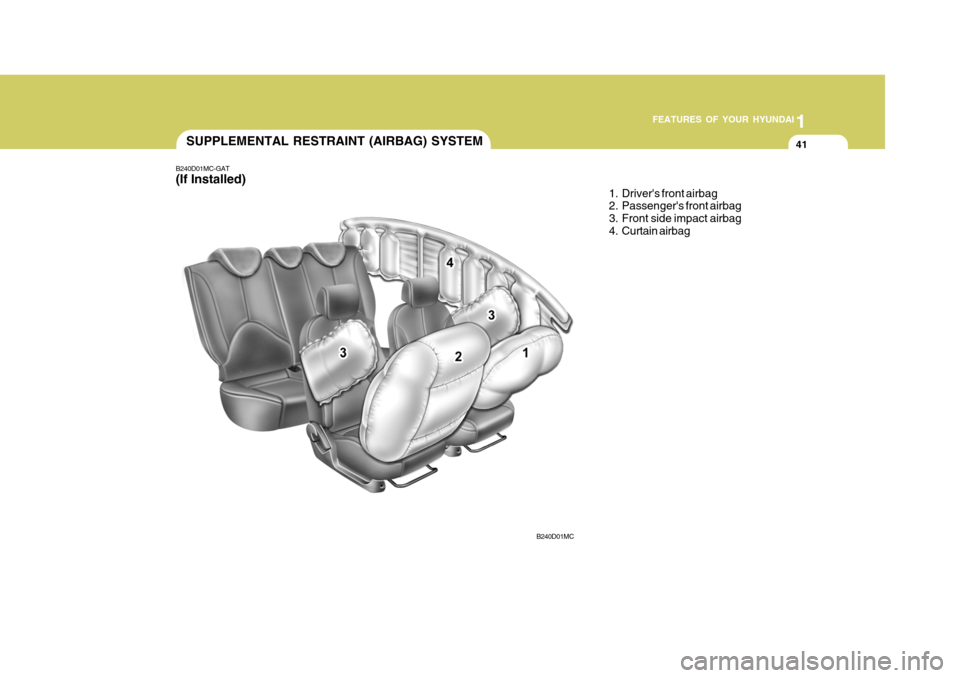
1
FEATURES OF YOUR HYUNDAI
41
B240D01MC-GAT (If Installed)
SUPPLEMENTAL RESTRAINT (AIRBAG) SYSTEM
1. Driver's front airbag
2. Passenger's front airbag
3. Front side impact airbag
4. Curtain airbag
B240D01MC
Page 56 of 599
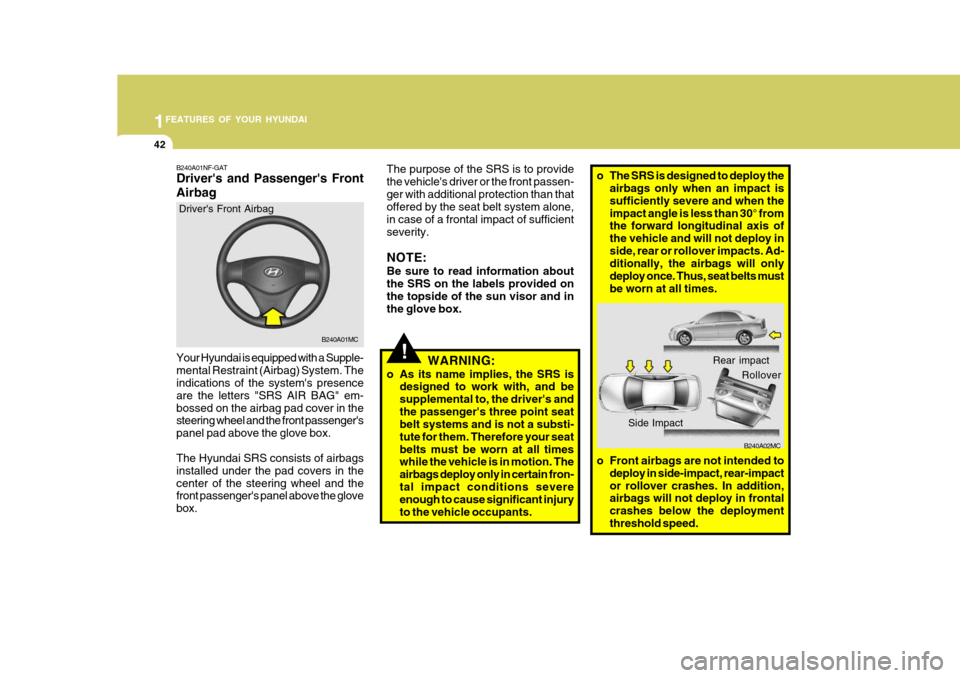
1FEATURES OF YOUR HYUNDAI
42
B240A01MC
Driver's Front Airbag
Your Hyundai is equipped with a Supple- mental Restraint (Airbag) System. The indications of the system's presence are the letters "SRS AIR BAG" em-bossed on the airbag pad cover in the steering wheel and the front passenger's panel pad above the glove box. The Hyundai SRS consists of airbags installed under the pad covers in thecenter of the steering wheel and the front passenger's panel above the glove box.
B240A01NF-GAT Driver's and Passenger's Front Airbag
!
o The SRS is designed to deploy the
airbags only when an impact is sufficiently severe and when theimpact angle is less than 30° from the forward longitudinal axis of the vehicle and will not deploy inside, rear or rollover impacts. Ad- ditionally, the airbags will only deploy once. Thus, seat belts mustbe worn at all times.
o Front airbags are not intended to deploy in side-impact, rear-impactor rollover crashes. In addition, airbags will not deploy in frontal crashes below the deploymentthreshold speed.
The purpose of the SRS is to providethe vehicle's driver or the front passen-ger with additional protection than that offered by the seat belt system alone, in case of a frontal impact of sufficientseverity. NOTE: Be sure to read information about the SRS on the labels provided onthe topside of the sun visor and in the glove box.
WARNING:
o As its name implies, the SRS is designed to work with, and be supplemental to, the driver's andthe passenger's three point seat belt systems and is not a substi- tute for them. Therefore your seatbelts must be worn at all times while the vehicle is in motion. The airbags deploy only in certain fron-tal impact conditions severe enough to cause significant injury to the vehicle occupants.
B240A02MC
Rear impact
Side Impact Rollover
Page 57 of 599
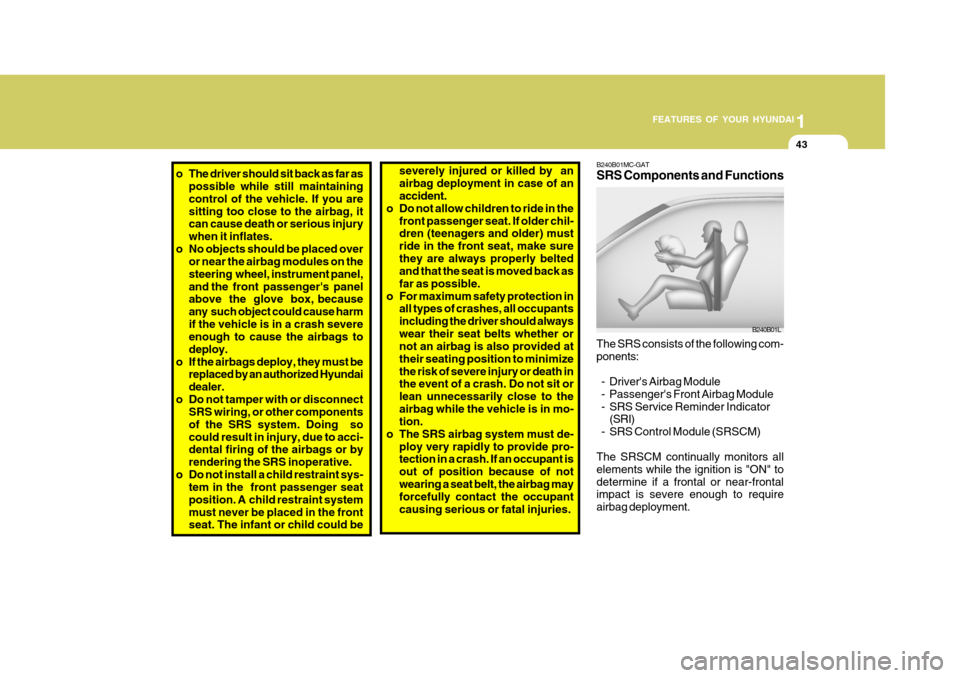
1
FEATURES OF YOUR HYUNDAI
43
severely injured or killed by an airbag deployment in case of an accident.
o Do not allow children to ride in the
front passenger seat. If older chil-dren (teenagers and older) must ride in the front seat, make surethey are always properly belted and that the seat is moved back as far as possible.
o For maximum safety protection in all types of crashes, all occupantsincluding the driver should alwayswear their seat belts whether or not an airbag is also provided at their seating position to minimizethe risk of severe injury or death in the event of a crash. Do not sit or lean unnecessarily close to theairbag while the vehicle is in mo- tion.
o The SRS airbag system must de- ploy very rapidly to provide pro-tection in a crash. If an occupant is out of position because of notwearing a seat belt, the airbag may forcefully contact the occupant causing serious or fatal injuries. The SRS consists of the following com-ponents:
- Driver's Airbag Module
- Passenger's Front Airbag Module
- SRS Service Reminder Indicator (SRI)
- SRS Control Module (SRSCM)
The SRSCM continually monitors allelements while the ignition is "ON" todetermine if a frontal or near-frontal impact is severe enough to require airbag deployment. B240B01MC-GAT SRS Components and Functions
B240B01L
o The driver should sit back as far as
possible while still maintaining control of the vehicle. If you aresitting too close to the airbag, it can cause death or serious injury when it inflates.
o No objects should be placed over or near the airbag modules on thesteering wheel, instrument panel,and the front passenger's panel above the glove box, because any such object could cause harmif the vehicle is in a crash severe enough to cause the airbags to deploy.
o If the airbags deploy, they must be replaced by an authorized Hyundaidealer.
o Do not tamper with or disconnect SRS wiring, or other componentsof the SRS system. Doing socould result in injury, due to acci- dental firing of the airbags or by rendering the SRS inoperative.
o Do not install a child restraint sys- tem in the front passenger seatposition. A child restraint systemmust never be placed in the front seat. The infant or child could be
Page 58 of 599
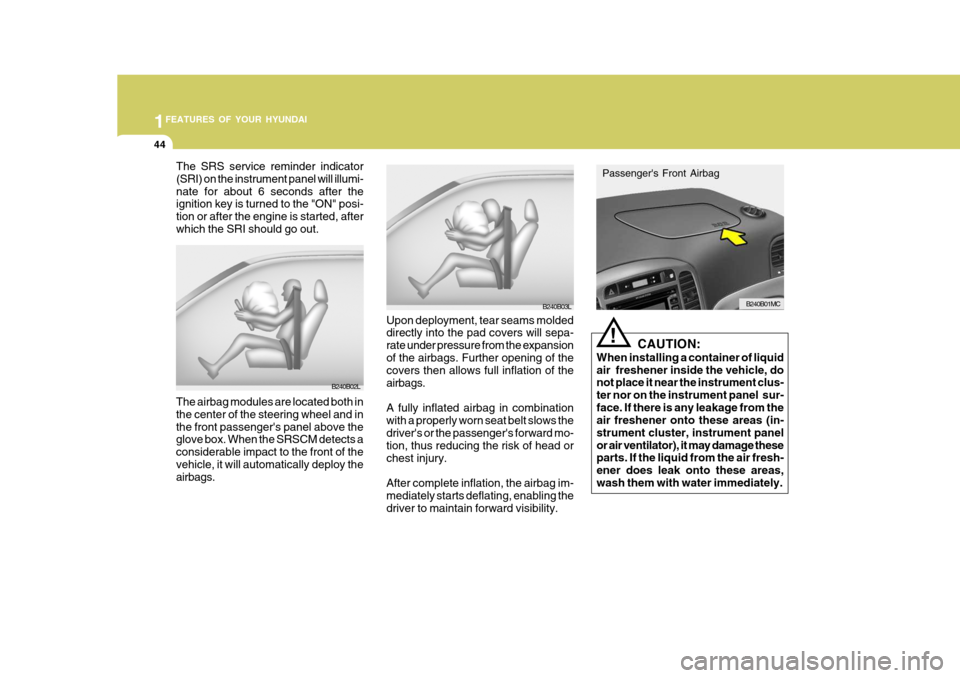
1FEATURES OF YOUR HYUNDAI
44
The SRS service reminder indicator (SRI) on the instrument panel will illumi-nate for about 6 seconds after the ignition key is turned to the "ON" posi- tion or after the engine is started, afterwhich the SRI should go out.
The airbag modules are located both inthe center of the steering wheel and inthe front passenger's panel above the glove box. When the SRSCM detects a considerable impact to the front of thevehicle, it will automatically deploy the airbags.
B240B02L
! CAUTION:
When installing a container of liquid air freshener inside the vehicle, do not place it near the instrument clus- ter nor on the instrument panel sur-face. If there is any leakage from the air freshener onto these areas (in- strument cluster, instrument panelor air ventilator), it may damage these parts. If the liquid from the air fresh- ener does leak onto these areas,wash them with water immediately.
Upon deployment, tear seams molded directly into the pad covers will sepa- rate under pressure from the expansionof the airbags. Further opening of the covers then allows full inflation of the airbags. A fully inflated airbag in combination with a properly worn seat belt slows thedriver's or the passenger's forward mo- tion, thus reducing the risk of head or chest injury. After complete inflation, the airbag im- mediately starts deflating, enabling thedriver to maintain forward visibility.
B240B03L
Passenger's Front Airbag
B240B01MC
Page 59 of 599
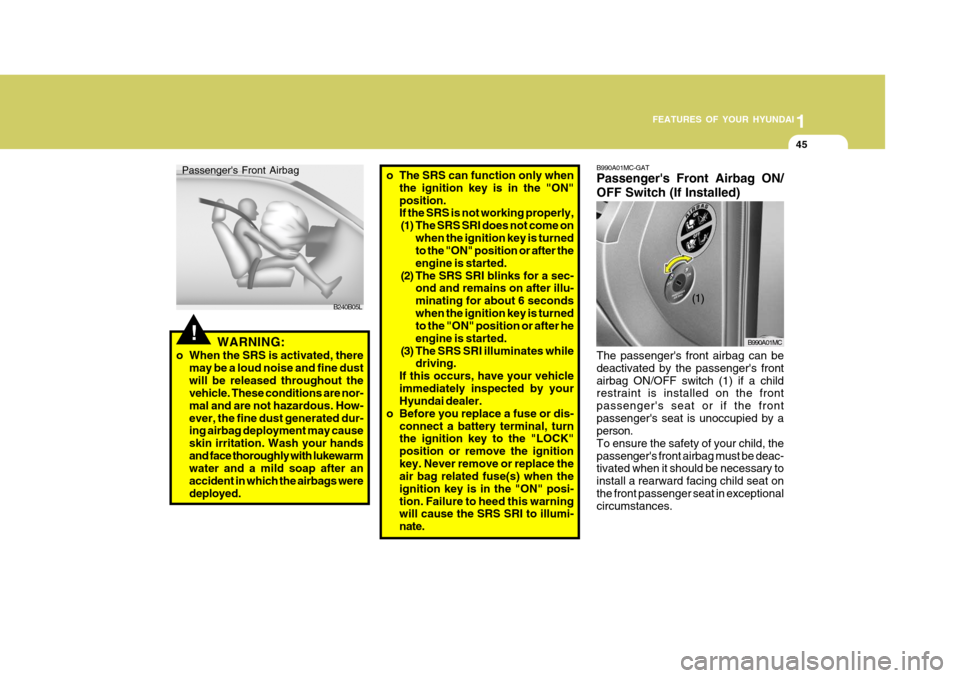
1
FEATURES OF YOUR HYUNDAI
45
o The SRS can function only when
the ignition key is in the "ON" position. If the SRS is not working properly,(1) The SRS SRI does not come on
when the ignition key is turnedto the "ON" position or after the engine is started.
(2) The SRS SRI blinks for a sec- ond and remains on after illu-minating for about 6 secondswhen the ignition key is turned to the "ON" position or after he engine is started.
(3) The SRS SRI illuminates while driving.
If this occurs, have your vehicleimmediately inspected by your Hyundai dealer.
o Before you replace a fuse or dis- connect a battery terminal, turnthe ignition key to the "LOCK" position or remove the ignitionkey. Never remove or replace the air bag related fuse(s) when the ignition key is in the "ON" posi-tion. Failure to heed this warning will cause the SRS SRI to illumi- nate.
!WARNING:
o When the SRS is activated, there may be a loud noise and fine dust will be released throughout the vehicle. These conditions are nor- mal and are not hazardous. How-ever, the fine dust generated dur- ing airbag deployment may cause skin irritation. Wash your handsand face thoroughly with lukewarm water and a mild soap after an accident in which the airbags weredeployed.
Passenger's Front Airbag
B240B05LB990A01MC-GAT Passenger's Front Airbag ON/ OFF Switch (If Installed)
B990A01MC
The passenger's front airbag can be deactivated by the passenger's frontairbag ON/OFF switch (1) if a child restraint is installed on the front passenger's seat or if the frontpassenger's seat is unoccupied by a person. To ensure the safety of your child, thepassenger's front airbag must be deac- tivated when it should be necessary to install a rearward facing child seat onthe front passenger seat in exceptional circumstances. (1)
Page 60 of 599
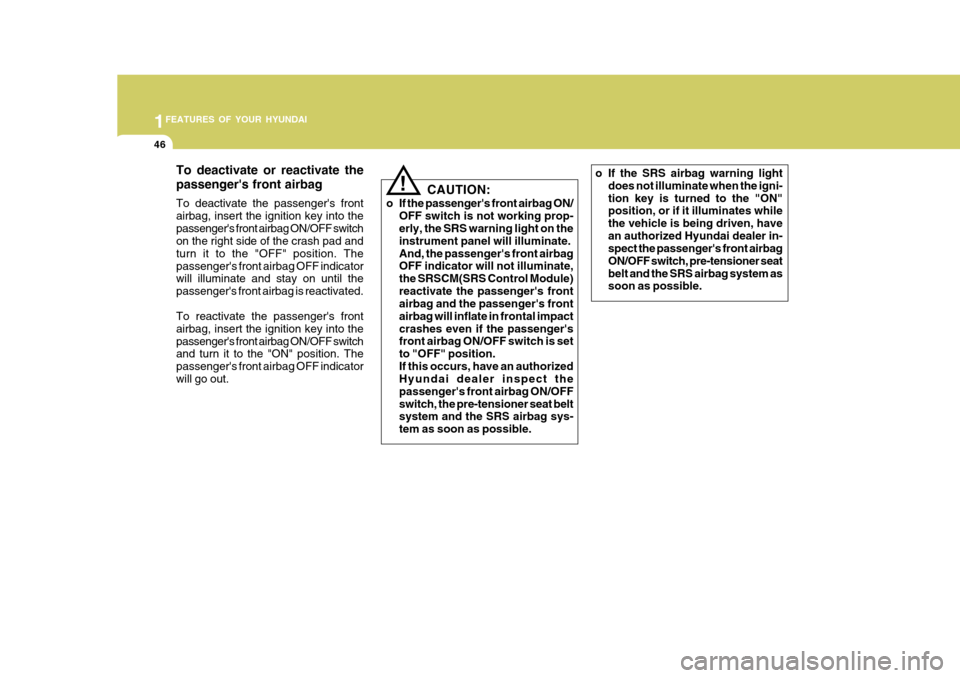
1FEATURES OF YOUR HYUNDAI
46
o If the SRS airbag warning lightdoes not illuminate when the igni- tion key is turned to the "ON" position, or if it illuminates while the vehicle is being driven, havean authorized Hyundai dealer in- spect the passenger's front airbag ON/OFF switch, pre-tensioner seatbelt and the SRS airbag system as soon as possible.
! CAUTION:
o If the passenger's front airbag ON/ OFF switch is not working prop- erly, the SRS warning light on the instrument panel will illuminate.And, the passenger's front airbag OFF indicator will not illuminate, the SRSCM(SRS Control Module)reactivate the passenger's front airbag and the passenger's front airbag will inflate in frontal impactcrashes even if the passenger's front airbag ON/OFF switch is set to "OFF" position.If this occurs, have an authorized Hyundai dealer inspect the passenger's front airbag ON/OFFswitch, the pre-tensioner seat belt system and the SRS airbag sys- tem as soon as possible.
To deactivate or reactivate the passenger's front airbag To deactivate the passenger's front airbag, insert the ignition key into thepassenger's front airbag ON/OFF switch on the right side of the crash pad and turn it to the "OFF" position. Thepassenger's front airbag OFF indicator will illuminate and stay on until the passenger's front airbag is reactivated. To reactivate the passenger's front airbag, insert the ignition key into thepassenger's front airbag ON/OFF switch and turn it to the "ON" position. The passenger's front airbag OFF indicatorwill go out.